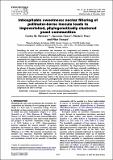Por favor, use este identificador para citar o enlazar a este item:
http://hdl.handle.net/10261/36796COMPARTIR / EXPORTAR:
 SHARE SHARE
 CORE
BASE CORE
BASE
|
|
| Visualizar otros formatos: MARC | Dublin Core | RDF | ORE | MODS | METS | DIDL | DATACITE | |

| Título: | Inhospitable sweetness: nectar filtering of pollinator-borne inocula leads to impoverished, phylogenetically clustered yeast communities |
Autor: | Herrera, Carlos M. CSIC ORCID; Canto, Azucena CSIC ORCID; Pozo, María I. CSIC; Bazaga, Pilar CSIC ORCID | Palabras clave: | community assembly rules environmental filtering; Helleborus foetidus Metschnikowia phylogenetic structure nectar yeast communities |
Fecha de publicación: | mar-2010 | Editor: | Royal Society (Great Britain) | Citación: | Proc. R. Soc. B (2010) 277, 747–754 | Resumen: | Identifying the rules and mechanisms that determine the composition and diversity of naturally co-occurring species assemblages is a central topic in community ecology. Although micro-organisms rep- resent the ‘unseen majority’ of species, individuals and biomass in many ecosystems and play pivotal roles in community development and function, the study of the factors influencing the assembly of microbial communities has lagged behind that of plant and animal communities. In this paper, we investigate exper- imentally the mechanisms accounting for the low species richness of yeast communities inhabiting the nectar of the bumble-bee-pollinated Helleborus foetidus (Ranunculaceae), and explore the relationships between community assembly rules and phylogenetic relatedness. By comparing yeast communities on the glossae of foraging bumble-bees (the potential species pool) with those eventually establishing in virgin nectar probed with bee glossae (the realized community), we address the questions: (i) does nectar filter yeast inocula, so that the communities eventually established there are not random subsamples of species on bumble-bee glossae? and (ii) do yeast communities establishing in H. foetidus nectar exhibit some phylogenetic bias relative to the species pool on bumble-bee glossae? Results show that nectar filtering leads to species-poor, phylogenetically clustered yeast communities that are a predict- able subset of pollinator-borne inocula. Such strong habitat filtering is probably due to H. foetidus nectar representing a harsh environment for most yeasts, where only a few phylogenetically related nectar specialists physiologically endowed to tolerate a combination of high osmotic pressure and fungicidal compounds are able to develop. | Versión del editor: | http://rspb.royalsocietypublishing.org/content/277/1682/747.full.pdf+html | URI: | http://hdl.handle.net/10261/36796 | DOI: | 10.1098/rspb.2009.1485 |
| Aparece en las colecciones: | (EBD) Artículos |
Ficheros en este ítem:
| Fichero | Descripción | Tamaño | Formato | |
|---|---|---|---|---|
| Herrera.et.al.2009.Proc.R.Soc.pdf | 233,9 kB | Adobe PDF |  Visualizar/Abrir |
CORE Recommender
PubMed Central
Citations
37
checked on 12-abr-2024
SCOPUSTM
Citations
121
checked on 11-abr-2024
WEB OF SCIENCETM
Citations
113
checked on 25-feb-2024
Page view(s)
253
checked on 15-abr-2024
Download(s)
168
checked on 15-abr-2024
Google ScholarTM
Check
Altmetric
Altmetric
Artículos relacionados:
NOTA: Los ítems de Digital.CSIC están protegidos por copyright, con todos los derechos reservados, a menos que se indique lo contrario.
